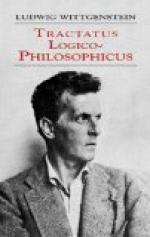5.2521 If an operation is applied repeatedly to its own results, I speak of successive applications of it. (’O’O’O’a’ is the result of three successive applications of the operation ‘O’E’ to ’a’.) In a similar sense I speak of successive applications of more than one operation to a number of propositions.
5.2522 Accordingly I use the sign ‘[a, x, O’x]’ for the general term of the series of forms a, O’a, O’O’a, ... . This bracketed expression is a variable: the first term of the bracketed expression is the beginning of the series of forms, the second is the form of a term x arbitrarily selected from the series, and the third is the form of the term that immediately follows x in the series.
5.2523 The concept of successive applications of an operation is equivalent to the concept ‘and so on’.
5.253 One operation can counteract the effect of another. Operations can cancel one another.
5.254 An operation can vanish (e.g. negation in ‘PPp’ : PPp = p).
5.3 All propositions are results of truth-operations on elementary propositions. A truth-operation is the way in which a truth-function is produced out of elementary propositions. It is of the essence of truth-operations that, just as elementary propositions yield a truth-function of themselves, so too in the same way truth-functions yield a further truth-function. When a truth-operation is applied to truth-functions of elementary propositions, it always generates another truth-function of elementary propositions, another proposition. When a truth-operation is applied to the results of truth-operations on elementary propositions, there is always a single operation on elementary propositions that has the same result. Every proposition is the result of truth-operations on elementary propositions.
5.31 The schemata in 4.31 have a meaning even when ‘p’, ‘q’, ‘r’, etc. are not elementary propositions. And it is easy to see that the propositional sign in 4.442 expresses a single truth-function of elementary propositions even when ‘p’ and ‘q’ are truth-functions of elementary propositions.
5.32 All truth-functions are results of successive applications to elementary propositions of a finite number of truth-operations.
5.4 At this point it becomes manifest that there are no ‘logical objects’ or ‘logical constants’ (in Frege’s and Russell’s sense).
5.41 The reason is that the results of truth-operations on truth-functions are always identical whenever they are one and the same truth-function of elementary propositions.
5.42 It is self-evident that C, z, etc. are not relations in the sense in which right and left etc. are relations. The interdefinability of Frege’s and Russell’s ‘primitive signs’ of logic is enough to show that they are not primitive signs, still less signs for relations. And it is obvious that the ‘z’ defined by means of ‘P’ and ‘C’ is identical with the one that figures with ‘P’ in the definition of ‘C’; and that the second ‘C’ is identical with the first one; and so on.




